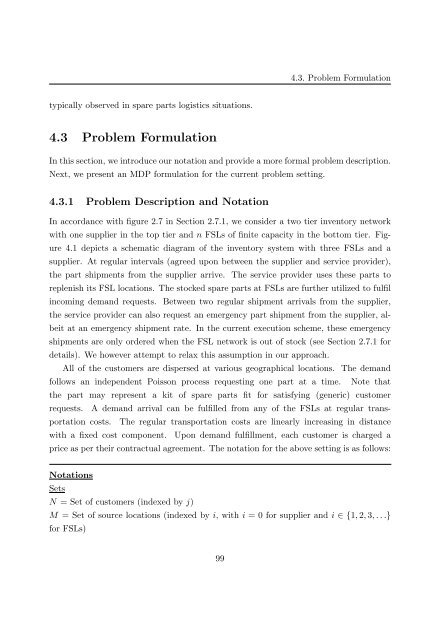Customer Information Driven After Sales Service ... - RePub
Customer Information Driven After Sales Service ... - RePub
Customer Information Driven After Sales Service ... - RePub
You also want an ePaper? Increase the reach of your titles
YUMPU automatically turns print PDFs into web optimized ePapers that Google loves.
typically observed in spare parts logistics situations.<br />
4.3 Problem Formulation<br />
4.3. Problem Formulation<br />
In this section, we introduce our notation and provide a more formal problem description.<br />
Next, we present an MDP formulation for the current problem setting.<br />
4.3.1 Problem Description and Notation<br />
In accordance with figure 2.7 in Section 2.7.1, we consider a two tier inventory network<br />
with one supplier in the top tier and n FSLs of finite capacity in the bottom tier. Figure<br />
4.1 depicts a schematic diagram of the inventory system with three FSLs and a<br />
supplier. At regular intervals (agreed upon between the supplier and service provider),<br />
the part shipments from the supplier arrive. The service provider uses these parts to<br />
replenish its FSL locations. The stocked spare parts at FSLs are further utilized to fulfil<br />
incoming demand requests. Between two regular shipment arrivals from the supplier,<br />
the service provider can also request an emergency part shipment from the supplier, albeit<br />
at an emergency shipment rate. In the current execution scheme, these emergency<br />
shipments are only ordered when the FSL network is out of stock (see Section 2.7.1 for<br />
details). We however attempt to relax this assumption in our approach.<br />
All of the customers are dispersed at various geographical locations. The demand<br />
follows an independent Poisson process requesting one part at a time. Note that<br />
the part may represent a kit of spare parts fit for satisfying (generic) customer<br />
requests. A demand arrival can be fulfilled from any of the FSLs at regular transportation<br />
costs. The regular transportation costs are linearly increasing in distance<br />
with a fixed cost component. Upon demand fulfillment, each customer is charged a<br />
price as per their contractual agreement. The notation for the above setting is as follows:<br />
Notations<br />
Sets<br />
N = Set of customers (indexed by j)<br />
M = Set of source locations (indexed by i, withi = 0 for supplier and i ∈{1, 2, 3,...}<br />
for FSLs)<br />
99

















